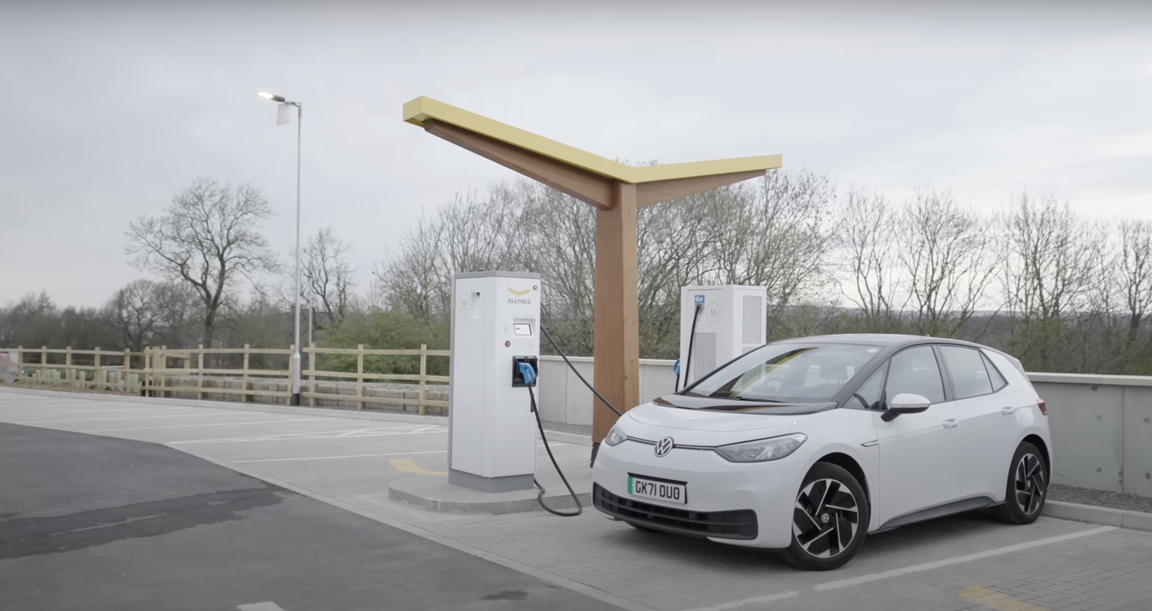June 2024
|Last updated:June 2024
Charged: 15 Questions with... Fastned
In April 2022, Fastned joined the Octopus Electroverse network.
Fastned started in 2012 and now, with over 300 stations across 7 countries, they're known for their speedy and efficient chargers - their funky, yellow charge points can't be missed!
To help us understand more about their future plans, we decided to sit down with Lieke Duijmelings for Fastned, to get the inside scoop.
Let's get plugged in...
(*You can check where your nearest Fastned charger is by searching the map or using the app filters)
Let's chat Fastned…
Give us a bit of background - how did Fastned start?
Fastned started 12 years ago with a chicken and egg question. Which comes first? People don’t want to buy EVs because there is no charging infrastructure, companies don’t want to build infrastructure because there is no EV demand. So when our co-founder Michiel Langezaal tried to drive across the Netherlands in a Nissan Leaf and there was only one fast charger in the lab he worked at in the middle of the country, he realised that you just need to start building. Together with Bart Lubbers, our other co-founder, they spoke to the Dutch Ministry of Infrastructure.
As a result of that in December 2011, the Dutch government published a public allocation procedure that allows parties to apply for a permit to build and operate charging stations for electric vehicles on service areas along Dutch highways. Fastned seized the opportunity and won the concession to 201 service area locations.
Where was the first Fastned electric charging site? How many charging sites, across how many countries, does Fastned now operate?
Fastned’s opened its first station, Palmpol, on the busiest highway of the Netherlands, in November 2013. Today, Fastned operates over 300 stations across seven countries.
In April this year, you opened your first official shop at Brecht station in Belgium! What inspired you to take the leap into store ownership? Are you planning on opening more?
Fastned has always aspired to have shops. When charging, customers might want to use the bathrooms, and get something to eat or drink and it makes no sense for this to only be available to petrol drivers. This is something we have steadily been working on with governments in many markets, as sometimes legislation needs to be changed. Brecht is the first fruit to bear from our efforts.
Next year we plan to open our first full electric station, Gentbrugge, in Belgium. The site is comprised of two large charging stations across from each other, both with shops.
Accessibility of EV charging has massively improved in recent years, with more and more high-quality chargers popping up all over the world. How would you say the industry has changed since Fastned first started, and how has Fastned adapted to remain a top-rated network?
The charging industry is still in its infancy. Our CEO Michiel Langezaal often says that it is still day 1 when it comes to charging. Throughout the whole industry, the reliability as well as the need for maintenance of fast chargers has improved significantly since 2013, but still has a ways to go. When we started, Fastned was a pioneer, and today we rank second in terms of number of charging sessions in Europe.
We offer the best charging experience, a concept that won several awards in our core markets. Our first advantage is reliability. With a station uptime of over 99.9%, a 24/7 multilingual customer service and in-house maintenance, customers know from experience that visiting a Fastned station means that they will be able to charge their EV. Our second advantage is convenience. We secure only high traffic locations, and our stations are highly visible from afar. Electric drivers can also use the Autocharge functionality everywhere on our network: after registering with their charge or bank card or bank in our app, it enables EV drivers to just roll up to our station and then just plug in their car to start the session!
Your eccentric and funky yellow charge points are very easily recognisable. What sort of design process was used when planning these?
Our canopies serve two purposes. One is shielding our customers against the elements, whether that be rain, sunlight, or darkness. The second purpose is visibility. Not only do we build a brand that customers will remember; we also make our stations visible for all drivers. They can see that charging stations are now everywhere, making the decision to go electric all the easier.
You recently got involved with Earth Day; some Fastned employees headed out to clean up the planet - one piece of garbage at a time! What else does Fastned do to aid and protect the environment?
Fastned has one mission, to accelerate the transition to electric mobility. With every kWh sold, we displace fossil fuels burning into the atmosphere. All the electricity we sell comes from renewable sources and our canopies, also called solar trees, have solar panels built into the roofs. We are always in the process of learning what we can improve. For example, at the beginning of 2023, we ran a pilot with the goal of trying to make one of our stations as emissions-free as possible. Fastned is also working towards receiving a B Corp certification.
When building a new charging site, what does Fastned prioritise?
Location location location. Our team of network developers search for high-traffic locations, to offer electric freedom to electric drivers when they need it. One of the first steps taken when securing a location is to secure, at the same time, a heavy-duty grid connection. Furthermore, Fastned makes sure that the future expansion of the station will be possible, when demand grows.
What charging speeds do Fastned currently offer, and what’s the future looking like for faster charging?
Fastned offers the most powerful charging speed on the market as staying up to date with the best technology will boost the transition to electric mobility. 81% of the chargers on the network are rated for between 300 to 400kW, and 16% from 150 to 175kw of power. Nowadays, a charging session takes 20 minutes and enables one to gain 300km of range, which is quite impressive.
Faster charging, higher density batteries, and larger volumes delivered per session—the future of fast charging is looking bright as innovations in the industry are taking place quite rapidly!
What’s the vision for Fastned in 5 years? Any further plans for global expansion?
Fastned’s goal is to build 1,000 stations across Europe by 2030. With over a third of our goal already built and our network expansion accelerating, we are getting closer.
Why are partnerships like Fastned and Octopus Electroverse crucial to the public charging infrastructure?
It’s all about offering electric drivers the freedom to go anywhere. Partners like Octopus Electroverse help make this possible by offering an attractive charge card and app that works almost everywhere.
About You...
Lieke Duijmelings, Commercial Director for Fastned
What's your dream electric vehicle?
My dream electric vehicle is one that will drive me anywhere I want while I take a cosy nap while being completely safe!
What’s the longest journey you’ve completed in an EV - and can you share the total mileage?
I once visited five of our offices in a single week. Apparently, that was not the record at Fastned, but it was close! In total, that was almost 2,000 kilometres.
Do you have an EV life hack to share with the EV community?
Fastned’s Autocharge is probably the biggest EV life hack out there, it is so convenient. All you need to do is take the charger and plug it in, that’s all. It works with the majority of EVs out there.
What advice would you give someone looking to use a Fastned charging location for the first time?
Try to arrive at the station when your battery is below 20%. That way you will be able to charge a lot faster. At Fastned you don’t need to keep anything in reserve “in case it doesn’t work” as it often happens with other fast chargers.
And finally- an EV etiquette question - what would you say is the golden rule to using a public charger?
Don’t charge more than 80%, at that time the charging speed becomes so slow that it is faster to just resume driving. On a long road trip, this can save you a couple of hours. The etiquette here is that when it is very busy, like certain holidays, others might be waiting for a charging spot and you don’t want to hold up the line longer than necessary.
Feeling enlightened or do you think something was missing? Let us know by sharing your feedback.
Interested in learning more? Head over to our Electroverse Community area for more electrifying content.










